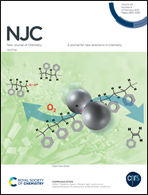Synthesis, bioactivity and 3D-QSAR of azamacrolide compounds with a carbamate or urea moiety as potential fungicides and inhibitors of quorum sensing†
Abstract
A series of azamacrolides containing the carbamate or urea moiety were synthesized and evaluated for their fungicidal activities against several agriculturally important pathogens. In addition, they were investigated for their ability to inhibit quorum sensing in Agrobacterium tumefaciens. The results showed that most of the derivatives had moderate to high fungicidal activities against the tested fungi, especially towards Sclerotinia sclerotiorum. Additionally, D16-19 could be used as a potential broad-spectrum fungicide while D16-4 exhibited a fungicidal activity (EC50 = 1.87 mg L−1) similar to that of carbendazim (EC50 = 1.34 mg L−1) against S. sclerotiorum. The three-dimensional Quantitative Structure–Activity Relationship (3D-QSAR) models were also established based on the experimental results and they would provide valuable information for further optimization. Moreover, D16-17 not only showed a better fungicidal activity against S. sclerotiorum but also had the highest ability to inhibit quorum sensing. These findings suggested that some azamacrolide compounds hold potential for the development of novel fungicides or inhibitors of quorum sensing.



 Please wait while we load your content...
Please wait while we load your content...